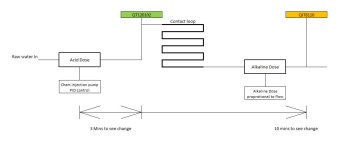sparkotronic
Member
Hi,
I'm looking for some advice or opinions on a control loop that I have been asked to look at and possibly modify.
The present system has been there for 10+ years and as far as I am aware it's never successfully worked.
My employer has the current set up which is shown in the attached drawing.
Using raw water, an acid is added which is then circulated round a contact loop, after the loop, an Alkali is added.
The expected end result of the loop is to achieve a specific alkali Ph.
The loop has 2 Ph probes which are selectable via SACDA and 2 dosing pumps.
The acid dosing pump is controlled by a PID loop where the SP is entered in the SCADA and the PV is measured from the selected Ph probe.
The Alkali dosing pump is purely proportional to flow.
In the PID block, the derivative is switched off.
One probe is just after the acid dose and the 2nd is just after the Alkali dose.
My employer wants to be able to control the acid dose by monitoring the Ph probe which is just after the Alkali dose and is also over 10 minutes process time after the acid dose.
I've been told that the system was designed to work this way, even though they have had no successes in running it this way.
My wee head can't process how I can control an acid dose while monitoring the after an Alkali has been added, the Alkali will raise the value by 5.
There is also only one set of PID parameters.
Looking at it, firstly I'd assume that each probe would require its own PID parameters.
I have had a play with it, but can't seem to get the loop to react to change and then recover in an acceptable time scale.
Could someone give me an opinion on whether the system could operate from the Alkali probe with some PID tweaking?
Thanks in advance,
Colin

I'm looking for some advice or opinions on a control loop that I have been asked to look at and possibly modify.
The present system has been there for 10+ years and as far as I am aware it's never successfully worked.
My employer has the current set up which is shown in the attached drawing.
Using raw water, an acid is added which is then circulated round a contact loop, after the loop, an Alkali is added.
The expected end result of the loop is to achieve a specific alkali Ph.
The loop has 2 Ph probes which are selectable via SACDA and 2 dosing pumps.
The acid dosing pump is controlled by a PID loop where the SP is entered in the SCADA and the PV is measured from the selected Ph probe.
The Alkali dosing pump is purely proportional to flow.
In the PID block, the derivative is switched off.
One probe is just after the acid dose and the 2nd is just after the Alkali dose.
My employer wants to be able to control the acid dose by monitoring the Ph probe which is just after the Alkali dose and is also over 10 minutes process time after the acid dose.
I've been told that the system was designed to work this way, even though they have had no successes in running it this way.
My wee head can't process how I can control an acid dose while monitoring the after an Alkali has been added, the Alkali will raise the value by 5.
There is also only one set of PID parameters.
Looking at it, firstly I'd assume that each probe would require its own PID parameters.
I have had a play with it, but can't seem to get the loop to react to change and then recover in an acceptable time scale.
Could someone give me an opinion on whether the system could operate from the Alkali probe with some PID tweaking?
Thanks in advance,
Colin




